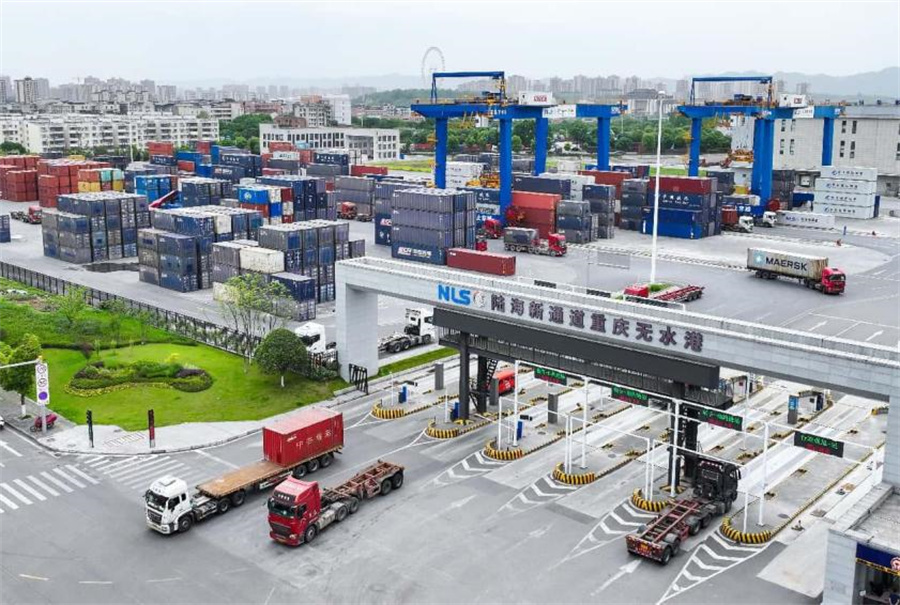China-Europe freight trains make 110,000 trips, marking new milestone

A fully loaded China-Europe freight train departs from the China-Kazakhstan (Lianyungang) Logistics Cooperation Base in Lianyungang, east China's Jiangsu province, June 10, 2025. [Photo by Wang Chun/People's Daily Online]
At 8:32 am on June 10, the whistle of a train pierced the morning air at Jiaozhou Railway Station in Qingdao, east China's Shandong province. Train No. 75052, a China-Europe freight train loaded with electronic displays and household appliances, rolled out on its transcontinental journey toward Europe.
With this departure, the total number of China-Europe freight train trips, including return trips, officially surpassed 110,000. Together, these trains have transported goods worth over $450 billion.
The China-Europe freight train service was launched in 2013 following the introduction of the Belt and Road Initiative. In 2016, it was brought under a single unified brand. By 2024, the annual number of trips had reached 19,000 - a 10.4-fold increase from the 1,702 trips recorded in 2016 - marking an average annual growth rate of 35%. The service has become a highly sought-after international public good.
The time required to operate every 10,000 trains has been reduced dramatically from 90 months at the start to just 6 months today. Currently, a China-Europe freight train departs roughly every 30 minutes, reflecting comprehensive upgrades in planning, coordination, and logistics.
A well-developed network of freight corridors now spans the continent. Domestically, China has established three major rail corridors: western, central, and eastern routes. Internationally, the network extends across northern, central, and southern corridors. So far, 128 Chinese cities have launched services linking to 229 cities in 26 European countries and over 100 cities in 11 Asian countries.
China's border ports have also undergone major capacity upgrades. In recent years, railway authorities have expanded capacity at five key ports—Alashankou, Horgos, Erenhot, Manzhouli, and Suifenhe - and developed the new Tongjiang North Railway Port. These six ports can now handle up to 184 train exchanges per day, marking a 45% increase from their 2016 levels.

Photo shows a land port in southwest China's Chongqing municipality. [Photo by Guo Jin/People's Daily Online]
For a long time, customs clearance posed a significant bottleneck. To address this, the railway sector introduced a digital port system, enabling border stations to pre-process customs paperwork based on departure data. Additionally, an express clearance mechanism has been rolled out to dramatically improve efficiency.
With this fast-track clearance system, companies no longer need to complete customs transfer declarations, releases, or reconciliations, explained Wang Shengyuan, general manager of a trade company in Ulanqab, north China's Inner Mongolia autonomous region.
"The system enables data sharing among customs, railways, and logistics operators. As a result, clearance time has been slashed from half a day to under 30 minutes - in some cases, just a few minutes," Wang noted.
Today, the China-Europe freight train service has evolved beyond simple rail lines. It has become a multi-modal logistics corridor connecting East Asia and Southeast Asia with Europe, integrating seamlessly with the New International Land-Sea Trade Corridor, coastal ports, and the Yangtze River golden shipping route.
On May 10 this year, a land-sea intermodal train carrying LCD TVs produced in Jakarta, Indonesia, departed from Qinzhou in south China's Guangxi Zhuang autonomous region. The cargo was transported to Chongqing in southwest China, where it underwent expedited customs clearance before joining a China-Europe freight train bound for Europe via the Horgos port in northwest China's Xinjiang Uygur autonomous region. The full journey is expected to take just 20 to 25 days.

A woman shops at a bonded store of imported goods by the China-Europe freight train service in Yinchuan, northwest China's Ningxia Hui autonomous region, March 23, 2025. [Photo by Wen Rui/People's Daily Online]
"In the past, goods from Indonesia could only reach Europe by sea," said Zhong Chaowen, deputy director of marketing at Guangxi Yanhai Railway Company. "Now, with intermodal rail-sea transport, the logistics timeline is more reliable."
Other innovations, such as the China-Kyrgyzstan-Uzbekistan road-rail intermodal transport service, are extending the freight train network's reach even further.
Recently, a train fully loaded with general merchandise arrived at Kashgar North Railway Station in Xinjiang. The goods were then transferred by truck and exited China through the Irkeshtam Port, en route to Tashkent, Uzbekistan.
"This route saves about five days in transit time and cuts costs by nearly 30% compared with traditional routes," said Fang Zijun, operations manager of a Kashgar-based logistics company.
The range of goods transported by China-Europe freight trains now includes 53 major categories and over 50,000 types of products - ranging from whole vehicles and machinery to furniture, textiles, and electronics. In 2024, high-value goods such as automobiles and auto parts, machinery, and electrical appliances made up more than 60% of outbound cargo.
Outbound and return trips are now roughly balanced, and the comprehensive ratio of loaded containers stands at nearly 100%. The annual value of transported goods has surged from $8 billion in 2016 to $66.4 billion in 2024, with the cumulative trade value exceeding $450 billion.
Beyond cargo, the trains are reshaping the regions they connect. In Europe, cities like Lodz in Poland, Duisburg in Germany, and Madrid in Spain - key hubs for China-Europe freight trains - are modernizing infrastructure and energizing related industries. In Kazakhstan, the freight train service has opened new maritime access points, allowing the country to export staple products like wheat to Southeast Asian markets via China.
This is a vivid example of win-win cooperation in action. Crossing mountains and rivers, the China-Europe freight trains continue to create new opportunities for development.
























